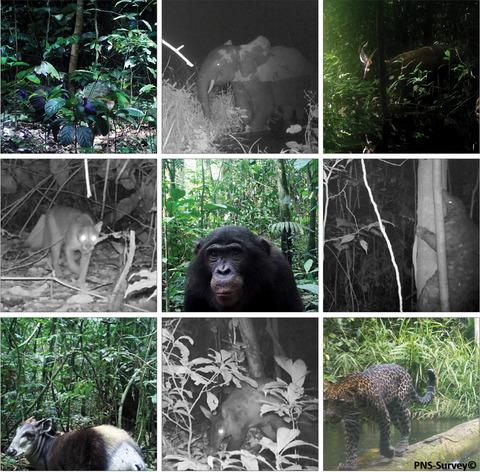当前位置:
X-MOL 学术
›
J. Appl. Ecol.
›
论文详情
Our official English website, www.x-mol.net, welcomes your feedback! (Note: you will need to create a separate account there.)
Drawn out of the shadows: Surveying secretive forest species with camera trap distance sampling
Journal of Applied Ecology ( IF 5.7 ) Pub Date : 2020-03-30 , DOI: 10.1111/1365-2664.13602 Mattia Bessone 1, 2 , Hjalmar S. Kühl 3, 4 , Gottfried Hohmann 3 , Ilka Herbinger 5 , Kouame Paul N'Goran 6 , Papy Asanzi 2 , Pedro B. Da Costa 2 , Violette Dérozier 2 , Ernest D. B. Fotsing 2 , Bernard Ikembelo Beka 2 , Mpongo D. Iyomi 2 , Iyomi B. Iyatshi 7 , Pierre Kafando 8 , Mbangi A. Kambere 2 , Dissondet B. Moundzoho 2 , Musubaho L. K. Wanzalire 2 , Barbara Fruth 1, 2, 9
Journal of Applied Ecology ( IF 5.7 ) Pub Date : 2020-03-30 , DOI: 10.1111/1365-2664.13602 Mattia Bessone 1, 2 , Hjalmar S. Kühl 3, 4 , Gottfried Hohmann 3 , Ilka Herbinger 5 , Kouame Paul N'Goran 6 , Papy Asanzi 2 , Pedro B. Da Costa 2 , Violette Dérozier 2 , Ernest D. B. Fotsing 2 , Bernard Ikembelo Beka 2 , Mpongo D. Iyomi 2 , Iyomi B. Iyatshi 7 , Pierre Kafando 8 , Mbangi A. Kambere 2 , Dissondet B. Moundzoho 2 , Musubaho L. K. Wanzalire 2 , Barbara Fruth 1, 2, 9
Affiliation

|
With animal species disappearing at unprecedented rates, we need an efficient monitoring method providing reliable estimates of population density and abundance, critical for the assessment of population status and trend. We deployed 160 camera traps (CTs) systematically over 743 locations covering 17,127 km2 of evergreen lowland rainforest of Salonga National Park, block South, Democratic Republic of the Congo. We evaluated the applicability of CT distance sampling (CTDS) to species different in size and behaviour. To improve precision of estimates, we evaluated two methods estimating species' availability (‘A’ ) for detection by CTs. We recorded 16,700 video clips, revealing 43 different animal taxa. We estimated densities of 14 species differing in physical, behavioural and ecological traits, and extracted species‐specific availability from available video footage using two methods (a) ‘ACa’ (Cappelle et al. [2019] Am . J . Primatol ., 81, e22962) and (b) ‘ARo’ (Rowcliffe et al. [2014] Methods Ecol . Evol . 5, 1170). With sample sizes being large enough, we found minor differences between ACa and ARo in estimated densities. In contrast, low detectability and reactivity to the camera were main sources of bias. CTDS proved efficient for estimating density of homogenously rather than patchily distributed species. Synthesis and applications. Our application of camera trap distance sampling (CTDS) to a diverse vertebrate community demonstrates the enormous potential of this methodology for surveys of terrestrial wildlife, allowing rapid assessments of species' status and trends that can translate into effective conservation strategies. By providing the first estimates of understudied species such as the Congo peafowl, the giant ground pangolin and the cusimanses, CTDS may be used as a tool to revise these species' conservation status in the IUCN Red List of Threatened Species. Based on the constraints we encountered, we identify improvements to the current application, enhancing the general applicability of this method.
中文翻译:

走出阴影:用相机陷阱距离采样调查秘密森林物种
随着动物物种以前所未有的速度消失,我们需要一种有效的监测方法,提供对种群密度和丰度的可靠估计,这对于评估种群状况和趋势至关重要。我们在 743 个地点系统地部署了 160 个相机陷阱 (CT),覆盖了刚果民主共和国南部萨隆加国家公园 17,127 平方公里的常绿低地雨林。我们评估了 CT 距离采样 (CTDS) 对大小和行为不同的物种的适用性。为了提高估计的精度,我们评估了两种估计物种可用性 ('A') 的方法,以供 CT 检测。我们录制了 16,700 个视频剪辑,揭示了 43 种不同的动物分类群。我们估计了 14 个在物理、行为和生态特征上不同的物种的密度,并使用两种方法(a)'ACa'(Cappelle et al. [2019] Am . J . Primatol ., 81, e22962)和(b)'ARo'(Rowcliffe et al. [2014] Methods Ecol . Evol . 5, 1170)。由于样本量足够大,我们发现 ACa 和 ARo 之间的估计密度差异很小。相比之下,对相机的低可检测性和反应性是偏差的主要来源。CTDS 被证明可以有效地估计均匀而不是零散分布的物种的密度。合成与应用。我们将相机陷阱距离采样 (CTDS) 应用于多样化的脊椎动物群落,证明了这种方法在陆地野生动物调查方面的巨大潜力,可以快速评估物种的状态和趋势,从而转化为有效的保护策略。通过提供对刚果孔雀、巨型地穿山甲和 cusimanses 等未充分研究物种的初步估计,CTDS 可用作修改这些物种在 IUCN 濒危物种红色名录中的保护状况的工具。根据我们遇到的限制,我们确定了对当前应用程序的改进,增强了该方法的普遍适用性。
更新日期:2020-03-30
中文翻译:

走出阴影:用相机陷阱距离采样调查秘密森林物种
随着动物物种以前所未有的速度消失,我们需要一种有效的监测方法,提供对种群密度和丰度的可靠估计,这对于评估种群状况和趋势至关重要。我们在 743 个地点系统地部署了 160 个相机陷阱 (CT),覆盖了刚果民主共和国南部萨隆加国家公园 17,127 平方公里的常绿低地雨林。我们评估了 CT 距离采样 (CTDS) 对大小和行为不同的物种的适用性。为了提高估计的精度,我们评估了两种估计物种可用性 ('A') 的方法,以供 CT 检测。我们录制了 16,700 个视频剪辑,揭示了 43 种不同的动物分类群。我们估计了 14 个在物理、行为和生态特征上不同的物种的密度,并使用两种方法(a)'ACa'(Cappelle et al. [2019] Am . J . Primatol ., 81, e22962)和(b)'ARo'(Rowcliffe et al. [2014] Methods Ecol . Evol . 5, 1170)。由于样本量足够大,我们发现 ACa 和 ARo 之间的估计密度差异很小。相比之下,对相机的低可检测性和反应性是偏差的主要来源。CTDS 被证明可以有效地估计均匀而不是零散分布的物种的密度。合成与应用。我们将相机陷阱距离采样 (CTDS) 应用于多样化的脊椎动物群落,证明了这种方法在陆地野生动物调查方面的巨大潜力,可以快速评估物种的状态和趋势,从而转化为有效的保护策略。通过提供对刚果孔雀、巨型地穿山甲和 cusimanses 等未充分研究物种的初步估计,CTDS 可用作修改这些物种在 IUCN 濒危物种红色名录中的保护状况的工具。根据我们遇到的限制,我们确定了对当前应用程序的改进,增强了该方法的普遍适用性。


























 京公网安备 11010802027423号
京公网安备 11010802027423号